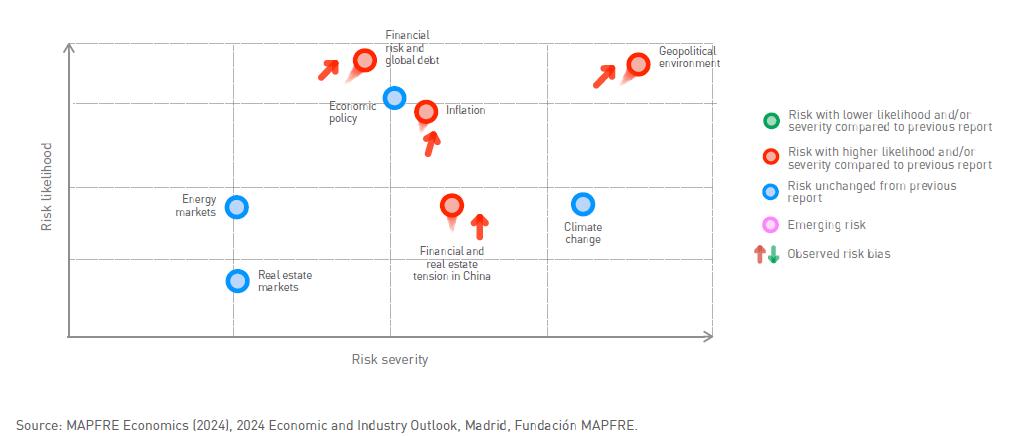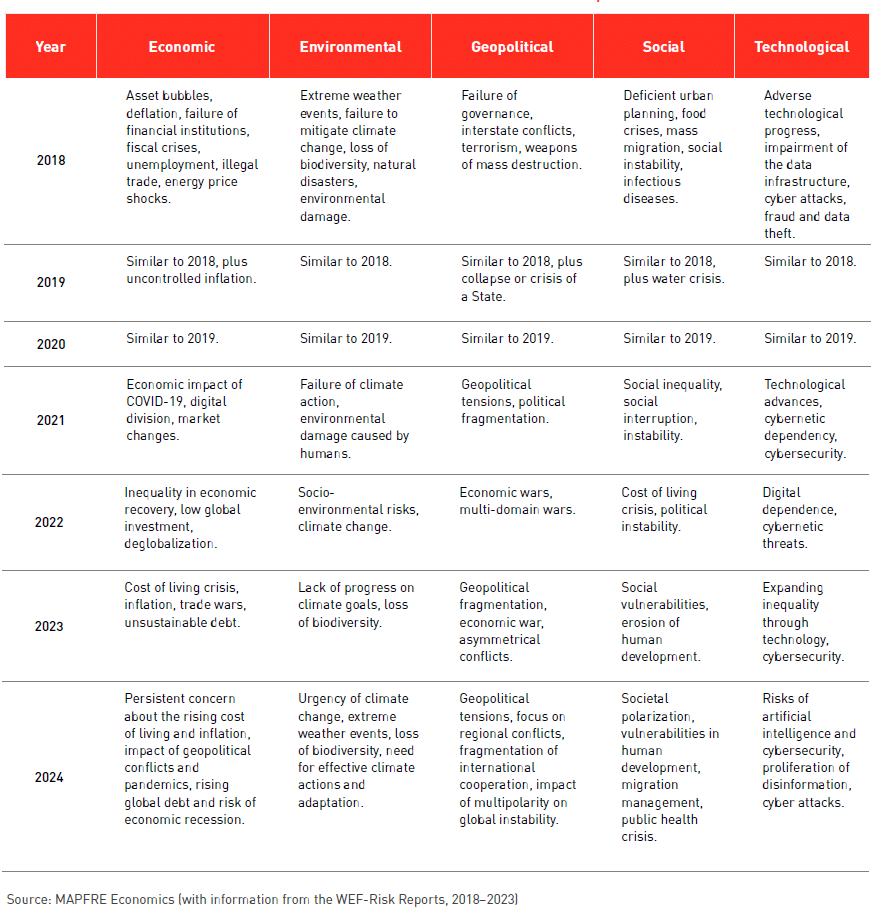Risk environment 2024-2026: classification and analysis
Author: MAPFRE Economics
Summary of the conclusions of the
MAPFRE Economics report
Risk environment 2024-2026: classification and analysis
Madrid, Fundación MAPFRE, May 2024
Effective risk management at the global level requires not only identifying and understanding individual risks, but also the capacity to anticipate and adapt to the complex interactions between them. The interrelationships between risk types and their potential impact on various aspects of society underscores the need for a multidisciplinary and collaborative focus to address these challenges.
MAPFRE Economics periodically conducts an analysis and validity exercise of social, economic and political risks that may impact on the economic forecasts and scenarios used in its Economic and Industry Outlook reports. These scenarios consider elements of risk that could transform the central (most probable) view into an alternative, less probable and surely more socioeconomically costly view, analyzing risks from four dimensions agreed upon in the financial literature[1]:
- Validity and proximity in time of its possible materialization
- Probability of occurrence
- Severity or expected cost if it materializes, and
- Centrality or capacity to interact with other risks.
Trends and current momentum of risks
Global economic growth tends to decline as a result of the structural phenomenon of the aging population, drop in participation in the labor force, and reduction in productivity levels.
Meanwhile, inflation is trending back, as a result of global transformations in production, demographics and strategies. The probability of a slowdown is inevitable, although an inflationary recession is not expected in the central scenario of the forecasts prepared by MAPFRE Economics. Inflation, which has shown a downward trend due to the normalization of supply chains and energy prices, has not yet reached the goals set by the main central banks. This outlook suggests a gradual adjustment of monetary policies toward a more neutral posture, in line with the need to address macroeconomic imbalances without precipitating an economic contraction. Inflation is nearing the monetary policy goals, while the output gap is slightly lower than desirable, which does not rule out the possibility of new supply shocks that could further destabilize the price stability objectives. In a context of waiting for confirming data, with the Federal Reserve and the European Central Bank postponing rate cuts until after Q2 2024, they are weighing whether the financial system is weakening, thus the debate of price stability versus financial stability is on their balance sheet of pros and cons.
In the complex risk landscape, challenges loom in global governance that pose significant threats at the national and global levels. International institutions are expected to face difficulties in the medium and long term managing issues such as climate change, humanitarian crises and geopolitical conflicts, generating a troubling gap in global response capacity. Disinformation and social polarization present a high probability risk over time. The ramifications of these phenomena include the erosion of trust in institutions, as well as challenges to social cohesion and governance.
The risk of diffuse, diverse and disruptive conflicts and violence, with a projected increase over the medium to long term, ranging from divergences between major powers to terrorist threats, suggests the possibility of more complex wars and high human and economic costs. The conflict in the Middle East, in particular, has emerged as a significant risk that could escalate, affecting global stability and altering economic forecasts.
In its Economic and Industry Outlook report, MAPFRE Economics establishes a risk framework for the short-term (two years ahead), in which it presents a detailed view of global socio-economic, health, technology, geopolitical and governance risks, which are in line with the typology of dimensions mentioned above. The main risks identified are focused primarily on the global economic slowdown, uncertainty in monetary and fiscal policy, moderate but persistent inflation, and the influence of geopolitics and international markets on the global economy. The likelihood and impact of these risks vary, but they all present significant challenges for the global economy in the coming years (See Chart 1).
Chart 1. Short-term risk balance: vulnerabilities and global risks

Those risks with a high probability of occurrence and high severity, such as geopolitical risk, inflation and the financial and global debt risk should be noted. With respect to the latter, global debt, rising interest rates, balance sheet reduction policies, and geopolitical conflicts form a set of risks in place since 2018 and 2019. These intricately interrelated elements have shaped the trajectory of global financial markets and pose challenges to global economic stability. There is consensus that while interest rates will be lower than 2022, the slope will be greater than the historical average with greater volatility.
There are four points by which global financial and debt risk is considered likely to operate, all leading to a situation of financial stress for liquidity and/or solvency reasons:
- public and private indebtedness (sovereign and credit risk). Total global debt currently (Q2 2024) amounts to approximately 335% of global GDP, while emerging markets have lower sovereign debt, although exposed to exchange rate risk.
- liquidity in the system. Ample liquidity in the system and expectations of dropping interest rates are facilitating a visible relaxation of global financial conditions, as well as credit conditions, and this is maintaining the liquidity and solvency situation for the time being.
- the solvency of specific segments in families and companies. We are witnessing moderately strong increases in delinquency and non-performing loans which, while not worrying in the solvency situation of the financial system, could be stressed in the event that high financing costs persist.
- “exuberance” in the valuation of specific assets. This overvaluation is found both in the financial sector in equities (tech) and in high-risk financial assets (due to excess liquidity). In a liquidity stress event, we could see a sharp adjustment in asset valuations, which could lead to solvency crises in certain economic segments.
Risks related to rising interest rates as well as construction and real estate development highlight the sensitivity of real estate markets to economic and financial factors, contributing to global risk dynamics. This type of high severity risk, although less severe than that experienced in the 2008 crisis thanks to the restructuring of the financial system and household balance sheets, is considered to be at a medium level below what the benchmark index would indicate (economic risk with social and political implications).
The reports prepared by MAPFRE Economics, both macroeconomic and industry-related, share a view of the current momentum and its main trends that is compatible with the consensus view, further finding important links between the trends described above and the emerging and dynamic risks detailed by the World Economic Forum (WEF) in its Global Risk Report. In summary, Table 1 shows the evolution matrix of risks in the 2018-2024 period perceived by the WEF.
Table 1. Matrix of evolving risks identified by the Worl Economic Forum in its 2018-2024 risk reports

Impact of geopolitical risk on the insurance industry
Geopolitical risks have a significant impact on the insurance industry. Lower growth in economic activity, as a result of the fragmentation of the global economy due to geopolitical tensions, would negatively affect insurance premium growth, which is tightly linked to GDP growth levels, and could impact the ability of insurance companies to diversify risks and increase the cost of claims. Thus, as economies diverge, driven by national security-driven changes, insurance companies face greater political uncertainty due to more disparate legal systems, potentially limiting their underwriting and investment potential, exposing them to compliance and reputational risks, and complicating or challenging their internationalization strategies. For example, insurance companies have dropped out of markets like Ukraine and reduced coverage in regions experiencing heightened tensions, such as Israel and Taiwan. On the contrary, insurance demand has increased in other parts of the world, indicating that geopolitical changes present both challenges and growth opportunities for insurance companies.
In summary, geopolitical tensions lead to a significant restructuring of global supply chains, exerting a major impact on the insurance industry, as replicating supply chains may come at too high a cost, thus stressing companies and governments. Meanwhile, they may complicate global collaborative efforts, which are essential and necessary to address critical threats such as climate change, energy security and health, among others, and could escalate into a “green cold war”, impacting the role of insurance companies in supporting transition projects.
Finally, we observe that main risks for the global economic environment include the global economic slowdown, the uncertainty of monetary and fiscal policy, inflation and the influence of geopolitics and the international markets. Within the energy markets there are elements such as oil and gas prices, the war in Ukraine, war tensions in the Middle East, OPEC production cuts, among others, which directly affect the dynamics of the global economy and are therefore considered to be economic risks of high subjective prevalence at present.
The complete analysis of the socioeconomic and geopolitical risks the world is facing and how it is responding to them can be found in the Risk Environment 2024-2026: classification and analysis report, prepared by MAPFRE Economics, available at the following link:
[1] See: documents 1 to 5 in the bibliography of MAPFRE Economics (2024), Risk environment 2024-2026: classification and analysis, Madrid, Fundación MAPFRE.



